Deck 7: Consumer Behavior
Question
Question
Question
Question
Question
Question
Question
Question
Question
Question
Question
Question
Question
Question
Question
Question
Question
Question
Question
Question
Question
Question
Question
Question
Question
Question
Question
Question
Question
Question
Question
Question
Question
Question
Question
Question
Question
Question
Question
Question
Question
Question
Question
Question
Question
Question
Question
Question
Question
Question
Question
Question
Question
Question
Question
Question
Question
Question
Question
Question
Question
Question
Question
Question
Question
Question
Question
Question
Question
Question
Question
Question
Question
Question
Question
Question
Question
Question
Question
Question

Unlock Deck
Sign up to unlock the cards in this deck!
Unlock Deck
Unlock Deck
1/104
Play
Full screen (f)
Deck 7: Consumer Behavior
1
A util is:
A) an objective measure of satisfaction with a universal interpretation.
B) the difference between total utility and average utility.
C) a subjective measure of satisfaction with no standard interpretation.
D) the total utility received from all units of consumption.
A) an objective measure of satisfaction with a universal interpretation.
B) the difference between total utility and average utility.
C) a subjective measure of satisfaction with no standard interpretation.
D) the total utility received from all units of consumption.
C
2
Your ultimate goal as a consumer is to get:
A) the most utility as possible out of the money that you spend.
B) a higher amount of utility than someone else.
C) the highest average utility possible.
D) more utility out of each additional unit of consumption.
A) the most utility as possible out of the money that you spend.
B) a higher amount of utility than someone else.
C) the highest average utility possible.
D) more utility out of each additional unit of consumption.
A
3
If Han and Gocan both get 25 utils from a pumpkin spice latte, what can be concluded from this information?
A) A pumpkin spice latte gives both Han and Gocan the same amount of happiness.
B) Both Han and Gocan will get the same amount of happiness from one additional pumpkin spice latte.
C) Han would be better off if he consumes something else that gives him 20 utils instead.
D) Gocan would be better off if he consumes something else that gives him 26 utils instead (assuming that the price of the substitute item is the same or less).
A) A pumpkin spice latte gives both Han and Gocan the same amount of happiness.
B) Both Han and Gocan will get the same amount of happiness from one additional pumpkin spice latte.
C) Han would be better off if he consumes something else that gives him 20 utils instead.
D) Gocan would be better off if he consumes something else that gives him 26 utils instead (assuming that the price of the substitute item is the same or less).
D
4
David and Chinhui both get 200 utils from four lunches at a local restaurant per month. What is true based on this information?
A) David and Chinhui have the same amount of happiness
B) David would be happier if he does something else that gives him 201 utils (assuming the price of the substitute item is the same or less).
C) The fourth lunch gives both David and Chinhui the same amount of additional utils.
D) Neither David nor Chinhui has the problem of diminishing marginal utility.
A) David and Chinhui have the same amount of happiness
B) David would be happier if he does something else that gives him 201 utils (assuming the price of the substitute item is the same or less).
C) The fourth lunch gives both David and Chinhui the same amount of additional utils.
D) Neither David nor Chinhui has the problem of diminishing marginal utility.

Unlock Deck
Unlock for access to all 104 flashcards in this deck.
Unlock Deck
k this deck
5
The combined utility that an individual receives from all the units consumed is known as _____ utility.
A) marginal
B) total
C) average
D) perfect
A) marginal
B) total
C) average
D) perfect

Unlock Deck
Unlock for access to all 104 flashcards in this deck.
Unlock Deck
k this deck
6
Every additional candy bar that you eat gives you less utility as you consume more of it. This statement captures the idea of _____ utility.
A) increasing average
B) diminishing marginal
C) constant marginal
D) decreasing total
A) increasing average
B) diminishing marginal
C) constant marginal
D) decreasing total

Unlock Deck
Unlock for access to all 104 flashcards in this deck.
Unlock Deck
k this deck
7
What is diminishing marginal utility?
A) the decrease in additional benefit that you receive from an additional unit of a good or service as you consume more of it
B) the decrease in total benefit that you receive from an additional unit of a good or service as you consume more of it
C) the change in the average amount of happiness that you receive from each additional unit of consumption
D) the change in the average amount of happiness that you receive from one less unit of consumption
A) the decrease in additional benefit that you receive from an additional unit of a good or service as you consume more of it
B) the decrease in total benefit that you receive from an additional unit of a good or service as you consume more of it
C) the change in the average amount of happiness that you receive from each additional unit of consumption
D) the change in the average amount of happiness that you receive from one less unit of consumption

Unlock Deck
Unlock for access to all 104 flashcards in this deck.
Unlock Deck
k this deck
8
When total utility _____ at a decreasing rate, marginal utility:
A) increases; increases.
B) increases; decreases.
C) decreases; stays the same.
D) decreases; increases.
A) increases; increases.
B) increases; decreases.
C) decreases; stays the same.
D) decreases; increases.

Unlock Deck
Unlock for access to all 104 flashcards in this deck.
Unlock Deck
k this deck
9
When marginal utility is _____, then total utility is:
A) positive; increasing.
B) equal to zero; equal to zero.
C) negative; increasing.
D) positive; negative.
A) positive; increasing.
B) equal to zero; equal to zero.
C) negative; increasing.
D) positive; negative.

Unlock Deck
Unlock for access to all 104 flashcards in this deck.
Unlock Deck
k this deck
10
Collin's total utility equals 150 utils after eating the third slice of pizza. After eating four slices of pizza, his total utility increases to 160 utils. What is true about Collin's utility from pizza?
A) His marginal utility from the fourth slice of pizza is 160 utils.
B) His marginal utility from the third slice of pizza is 150 utils.
C) His marginal utility from the fourth slice of pizza is larger than his marginal utility from the third slice of pizza.
D) His marginal utility from the fourth slice of pizza is 10 utils.
A) His marginal utility from the fourth slice of pizza is 160 utils.
B) His marginal utility from the third slice of pizza is 150 utils.
C) His marginal utility from the fourth slice of pizza is larger than his marginal utility from the third slice of pizza.
D) His marginal utility from the fourth slice of pizza is 10 utils.

Unlock Deck
Unlock for access to all 104 flashcards in this deck.
Unlock Deck
k this deck
11
When Ciara consumes one glass of lemonade, it yields her 75 utils, and when she consumes one more glass of lemonade, her satisfaction increases by 25 utils. What is true about Ciara's utility for lemonade?
A) The total utility of consuming two cups of lemonade is 100 utils.
B) The total utility of consuming two cups of lemonade is 25 utils.
C) The marginal utility of consuming the second lemonade is 100 utils.
D) The marginal utility of consuming the second lemonade is 50 utils.
A) The total utility of consuming two cups of lemonade is 100 utils.
B) The total utility of consuming two cups of lemonade is 25 utils.
C) The marginal utility of consuming the second lemonade is 100 utils.
D) The marginal utility of consuming the second lemonade is 50 utils.

Unlock Deck
Unlock for access to all 104 flashcards in this deck.
Unlock Deck
k this deck
12
Use the table Utility from Roller Coaster Rides I. What is the total utility from three roller coaster rides?
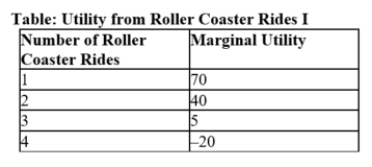
A) 45
B) 35
C) 5
D) 115

A) 45
B) 35
C) 5
D) 115

Unlock Deck
Unlock for access to all 104 flashcards in this deck.
Unlock Deck
k this deck
13
Use the table Utility from Roller Coaster Rides I. What is the total utility from two roller coaster rides?

A) 45
B) 110
C) 35
D) 40

A) 45
B) 110
C) 35
D) 40

Unlock Deck
Unlock for access to all 104 flashcards in this deck.
Unlock Deck
k this deck
14
Use the table Utility from Roller Coaster Rides II. What quantity has a negative marginal utility?
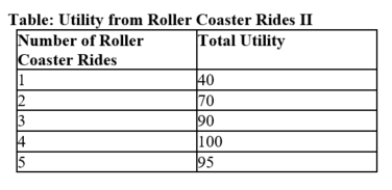
A) two rides
B) three rides
C) four rides
D) five rides

A) two rides
B) three rides
C) four rides
D) five rides

Unlock Deck
Unlock for access to all 104 flashcards in this deck.
Unlock Deck
k this deck
15
Use the table Number of Roller Coaster Rides II. What is the marginal utility of the third roller coaster ride?
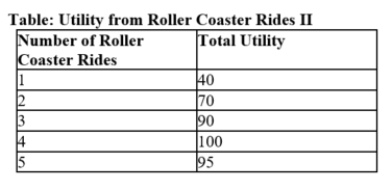
A) 90
B) 10
C) 20
D) 110

A) 90
B) 10
C) 20
D) 110

Unlock Deck
Unlock for access to all 104 flashcards in this deck.
Unlock Deck
k this deck
16
A consumer's objective is to maximize _____ utility.
A) total
B) marginal
C) average
D) diminished
A) total
B) marginal
C) average
D) diminished

Unlock Deck
Unlock for access to all 104 flashcards in this deck.
Unlock Deck
k this deck
17
Use the table Sorenson's Utility from Eating Lunches at a Restaurant. What is Sorenson's total utility from eating three lunches?
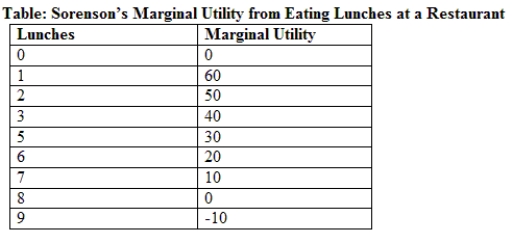
A) 150
B) 30
C) 50
D) 90

A) 150
B) 30
C) 50
D) 90

Unlock Deck
Unlock for access to all 104 flashcards in this deck.
Unlock Deck
k this deck
18
Use the table Sorenson's Utility from Eating Lunches at a Restaurant. What quantity decreases Sorenson's total utility?
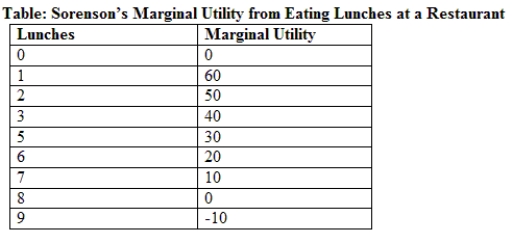
A) one lunch
B) three lunches
C) seven lunches
D) nine lunches

A) one lunch
B) three lunches
C) seven lunches
D) nine lunches

Unlock Deck
Unlock for access to all 104 flashcards in this deck.
Unlock Deck
k this deck
19
Use the table Sorenson's Utility from Eating Lunches at a Restaurant. What happens to Sorenson's total utility if he changes from eating eight lunches to eating nine lunches?
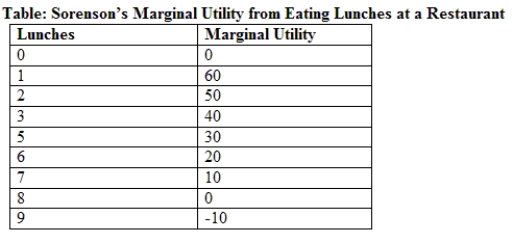
A) It increases by nine utils.
B) It stays the same.
C) It increases by 10 utils.
D) It decreases by 10 utils.

A) It increases by nine utils.
B) It stays the same.
C) It increases by 10 utils.
D) It decreases by 10 utils.

Unlock Deck
Unlock for access to all 104 flashcards in this deck.
Unlock Deck
k this deck
20
Use the table Sorenson's Utility from Eating Lunches at a Restaurant. Which of the following quantities of lunches will NOT increase Sorenson's total utility?
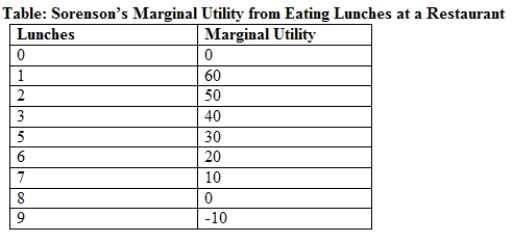
A) one lunch
B) five lunches
C) six lunches
D) nine lunches

A) one lunch
B) five lunches
C) six lunches
D) nine lunches

Unlock Deck
Unlock for access to all 104 flashcards in this deck.
Unlock Deck
k this deck
21
Use the table Jackson's Total Utility for Cupcakes. What is the marginal utility of Jackson's first cupcake?
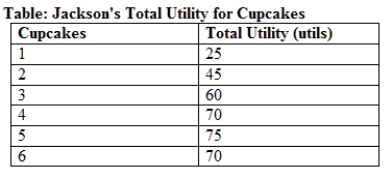
A) 25
B) 20
C) 45
D) zero

A) 25
B) 20
C) 45
D) zero

Unlock Deck
Unlock for access to all 104 flashcards in this deck.
Unlock Deck
k this deck
22
Use the table Jackson's Total Utility for Cupcakes. What is the marginal utility of Jackson's second cupcake?
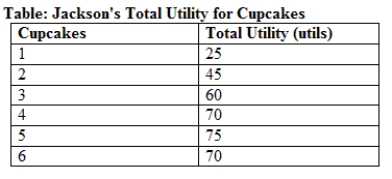
A) 25
B) 20
C) 45
D) 10

A) 25
B) 20
C) 45
D) 10

Unlock Deck
Unlock for access to all 104 flashcards in this deck.
Unlock Deck
k this deck
23
Use the table Jackson's Total Utility for Cupcakes. What is the marginal utility of Jackson's third cupcake?
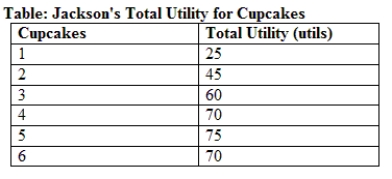
A) 60
B) 20
C) 45
D) 15

A) 60
B) 20
C) 45
D) 15

Unlock Deck
Unlock for access to all 104 flashcards in this deck.
Unlock Deck
k this deck
24
Use the table Jackson's Total Utility for Cupcakes. What is the marginal utility of Jackson's fourth cupcake?
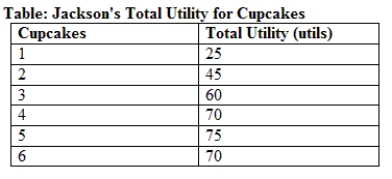
A) 70
B) 20
C) 10
D) 15

A) 70
B) 20
C) 10
D) 15

Unlock Deck
Unlock for access to all 104 flashcards in this deck.
Unlock Deck
k this deck
25
Use the table Jackson's Total Utility for Cupcakes. What is the marginal utility of Jackson's fifth cupcake?

A) 5
B) 20
C) 75
D) -5

A) 5
B) 20
C) 75
D) -5

Unlock Deck
Unlock for access to all 104 flashcards in this deck.
Unlock Deck
k this deck
26
Use the table Jackson's Total Utility for Cupcakes. What is the marginal utility of Jackson's sixth cupcake?
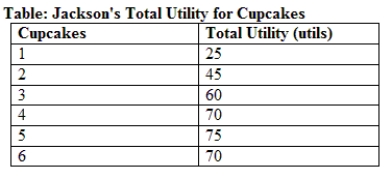
A) 75
B) -5
C) 70
D) 5

A) 75
B) -5
C) 70
D) 5

Unlock Deck
Unlock for access to all 104 flashcards in this deck.
Unlock Deck
k this deck
27
Use the table Jackson's Total Utility for Cupcakes. For what cupcake is Jackson's marginal utility the highest?
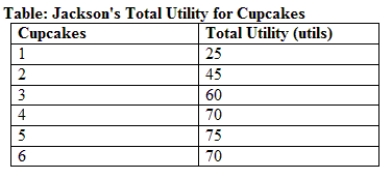
A) fifth cupcake
B) sixth cupcake
C) first cupcake
D) second cupcake

A) fifth cupcake
B) sixth cupcake
C) first cupcake
D) second cupcake

Unlock Deck
Unlock for access to all 104 flashcards in this deck.
Unlock Deck
k this deck
28
Use the table Jackson's Total Utility for Cupcakes. How many cupcakes will Jackson choose to consume if cupcakes are free?
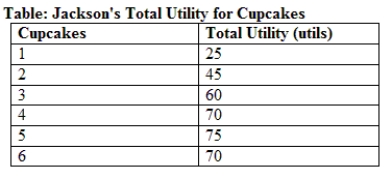
A) 75 cupcakes
B) one cupcake
C) five cupcakes
D) six cupcakes

A) 75 cupcakes
B) one cupcake
C) five cupcakes
D) six cupcakes

Unlock Deck
Unlock for access to all 104 flashcards in this deck.
Unlock Deck
k this deck
29
Use the table Rebecca's Marginal Utility and Total Utility for Magazines. How many magazines give Rebecca the most total happiness?

A) one magazine
B) six magazines
C) five magazines
D) three magazines

A) one magazine
B) six magazines
C) five magazines
D) three magazines

Unlock Deck
Unlock for access to all 104 flashcards in this deck.
Unlock Deck
k this deck
30
A _____ is the set of points on a graph that exhaust a consumer's budget.
A) utility curve
B) marginal utility curve
C) total utility curve
D) budget constraint
A) utility curve
B) marginal utility curve
C) total utility curve
D) budget constraint

Unlock Deck
Unlock for access to all 104 flashcards in this deck.
Unlock Deck
k this deck
31
. Use the figure Aimee's Budget Constraint. If Aimee has $100 to spend, what is the cost of a magazine based on this budget constraint?
Figure: Aimee's Budget Constraint

A) $5
B) $20
C) $1
D) $25
Figure: Aimee's Budget Constraint

A) $5
B) $20
C) $1
D) $25

Unlock Deck
Unlock for access to all 104 flashcards in this deck.
Unlock Deck
k this deck
32
. Use the figure Aimee's Budget Constraint. If Aimee has $100 to spend, what is the cost of a baseball ticket?
Figure: Aimee's Budget Constraint
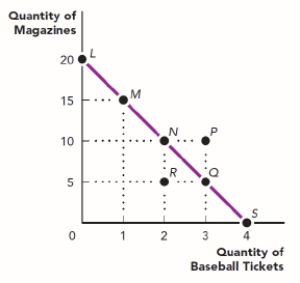
A) $5
B) $20
C) $1
D) $25
Figure: Aimee's Budget Constraint

A) $5
B) $20
C) $1
D) $25

Unlock Deck
Unlock for access to all 104 flashcards in this deck.
Unlock Deck
k this deck
33
. Use the figure Aimee's Budget Constraint. If each magazine costs $5, how much does Aimee have to spend?
Figure: Aimee's Budget Constraint
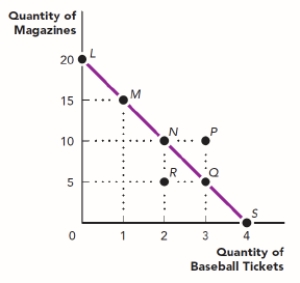
A) $120
B) $20
C) $100
D) $50
Figure: Aimee's Budget Constraint

A) $120
B) $20
C) $100
D) $50

Unlock Deck
Unlock for access to all 104 flashcards in this deck.
Unlock Deck
k this deck
34
. Use the figure Aimee's Budget Constraint. Which point represents a point that is not affordable?
Figure: Aimee's Budget Constraint
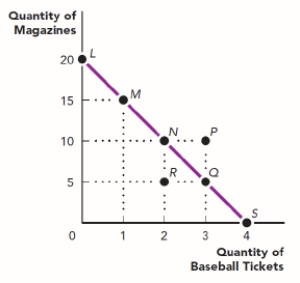
A) L
B) M
C) P
D) R
Figure: Aimee's Budget Constraint

A) L
B) M
C) P
D) R

Unlock Deck
Unlock for access to all 104 flashcards in this deck.
Unlock Deck
k this deck
35
. Use the figure Aimee's Budget Constraint. At which point would Aimee have money leftover?
Figure: Aimee's Budget Constraint
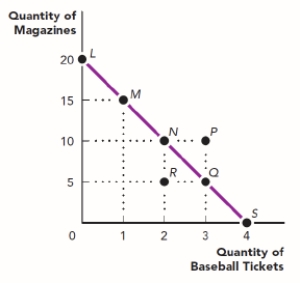
A) L
B) S
C) P
D) R
Figure: Aimee's Budget Constraint

A) L
B) S
C) P
D) R

Unlock Deck
Unlock for access to all 104 flashcards in this deck.
Unlock Deck
k this deck
36
What happens to a consumer's budget constraint if the amount of money he or she has to spend increases?
A) It shifts out.
B) It shifts in.
C) It rotates to a new intersection on the vertical axis but not on the horizontal axis.
D) It rotates to a new intersection on the horizontal axis but not on the vertical axis.
A) It shifts out.
B) It shifts in.
C) It rotates to a new intersection on the vertical axis but not on the horizontal axis.
D) It rotates to a new intersection on the horizontal axis but not on the vertical axis.

Unlock Deck
Unlock for access to all 104 flashcards in this deck.
Unlock Deck
k this deck
37
Every point on a budget constraint represents a point that:
A) gives you the highest marginal utility.
B) is an option that a consumer can choose.
C) is an option that is unattainable.
D) minimizes diminishing marginal utility.
A) gives you the highest marginal utility.
B) is an option that a consumer can choose.
C) is an option that is unattainable.
D) minimizes diminishing marginal utility.

Unlock Deck
Unlock for access to all 104 flashcards in this deck.
Unlock Deck
k this deck
38
. Use the figure Aimee's Budget Constraint. The price of a magazine is $5, and the price of a baseball ticket is $25. What is true if Aimee's income increases by $25?
Figure: Aimee's Budget Constraint
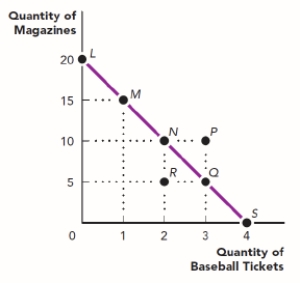
A) Point S is no longer an option that she can choose from.
B) Option L will maximize her utility.
C) Point P will be an option that she can choose from.
D) Point N will be unattainable.
Figure: Aimee's Budget Constraint

A) Point S is no longer an option that she can choose from.
B) Option L will maximize her utility.
C) Point P will be an option that she can choose from.
D) Point N will be unattainable.

Unlock Deck
Unlock for access to all 104 flashcards in this deck.
Unlock Deck
k this deck
39
. Use the figure Aimee's Budget Constraint. Which point represents a point where Aimee does NOT spend her entire budget?
Figure: Aimee's Budget Constraint
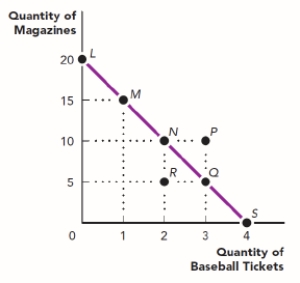
A) N
B) P
C) Q
D) R
Figure: Aimee's Budget Constraint

A) N
B) P
C) Q
D) R

Unlock Deck
Unlock for access to all 104 flashcards in this deck.
Unlock Deck
k this deck
40
When there is an increase in your budget, the budget constraint shifts out because you can afford:
A) more of the good on the vertical axis but not on the horizontal axis.
B) fewer units of both goods.
C) more units of both goods.
D) more of the good on the horizontal axis but not on the vertical axis.
A) more of the good on the vertical axis but not on the horizontal axis.
B) fewer units of both goods.
C) more units of both goods.
D) more of the good on the horizontal axis but not on the vertical axis.

Unlock Deck
Unlock for access to all 104 flashcards in this deck.
Unlock Deck
k this deck
41
Podrick enjoys consuming sandwiches (S) and juice boxes (J). Suppose that Podrick has $20 in his budget, the price of a sandwich is $4, and the price of a juice box is $2. Which of the following combinations uses exactly his $20 budget?
A) 0 S and 5 J
B) 10 S and 0 J
C) 2 S and 2 J
D) 2 S and 6 J
A) 0 S and 5 J
B) 10 S and 0 J
C) 2 S and 2 J
D) 2 S and 6 J

Unlock Deck
Unlock for access to all 104 flashcards in this deck.
Unlock Deck
k this deck
42
Podrick enjoys consuming sandwiches (S) and juice boxes (J). Suppose that Podrick has $20 in his budget, the price of a sandwich is $4, and the price of a juice box is $2. Which of the following combinations uses exactly his $20 budget?
A) 0 S and 5 J
B) 10 S and 0 J
C) 3 S and 4 J
D) 4 S and 6 J
A) 0 S and 5 J
B) 10 S and 0 J
C) 3 S and 4 J
D) 4 S and 6 J

Unlock Deck
Unlock for access to all 104 flashcards in this deck.
Unlock Deck
k this deck
43
Podrick enjoys consuming sandwiches (S) and juice boxes (J). Suppose that Podrick has $20 in his budget, the price of a sandwich is $4, and the price of a juice box is $2. Which of the following combinations uses more than his $20 budget?
A) 0 S and 5 J
B) 10 S and 0 J
C) 2 S and 2 J
D) 2 S and 6 J
A) 0 S and 5 J
B) 10 S and 0 J
C) 2 S and 2 J
D) 2 S and 6 J

Unlock Deck
Unlock for access to all 104 flashcards in this deck.
Unlock Deck
k this deck
44
Podrick enjoys consuming sandwiches (S) and juice boxes (J). Suppose that Podrick has $20 in his budget, the price of a sandwich is $4, and the price of a juice box is $2. Which of the following combinations uses more than his $20 budget?
A) 0 S and 5 J
B) 1 S and 8 J
C) 2 S and 2 J
D) 3 S and 5 J
A) 0 S and 5 J
B) 1 S and 8 J
C) 2 S and 2 J
D) 3 S and 5 J

Unlock Deck
Unlock for access to all 104 flashcards in this deck.
Unlock Deck
k this deck
45
Podrick enjoys consuming sandwiches (S) and juice boxes (J). Suppose that Podrick has $20 in his budget, the price of a sandwich is $4, and the price of a juice box is $2. Which of the following combinations uses more than his $20 budget?
A) 0 S and 5 J
B) 4 S and 0 J
C) 3 S and 5 J
D) 2 S and 6 J
A) 0 S and 5 J
B) 4 S and 0 J
C) 3 S and 5 J
D) 2 S and 6 J

Unlock Deck
Unlock for access to all 104 flashcards in this deck.
Unlock Deck
k this deck
46
Podrick enjoys consuming sandwiches (S) and juice boxes (J). Suppose that Podrick has $20 in his budget, the price of a sandwich is $4, and the price of a juice box is $2. Which of the following combinations uses less than his $20 budget?
A) 0 S and 5 J
B) 5 S and 0 J
C) 3 S and 5 J
D) 2 S and 6 J
A) 0 S and 5 J
B) 5 S and 0 J
C) 3 S and 5 J
D) 2 S and 6 J

Unlock Deck
Unlock for access to all 104 flashcards in this deck.
Unlock Deck
k this deck
47
Podrick enjoys consuming sandwiches (S) and juice boxes (J). Suppose that Podrick has $20 in his budget, the price of a sandwich is $4, and the price of a juice box is $2. Which of the following combinations uses less than his $20 budget?
A) 0 S and 10 J
B) 4 S and 0 J
C) 3 S and 5 J
D) 2 S and 6 J
A) 0 S and 10 J
B) 4 S and 0 J
C) 3 S and 5 J
D) 2 S and 6 J

Unlock Deck
Unlock for access to all 104 flashcards in this deck.
Unlock Deck
k this deck
48
Podrick enjoys consuming sandwiches (S) and juice boxes (J). Suppose that Podrick has $20 in his budget, the price of a sandwich is $4, and the price of a juice box is $2. Which of the following combinations uses less than his $20 budget?
A) 0 S and 10 J
B) 5 S and 0 J
C) 4 S and 2 J
D) 2 S and 3 J
A) 0 S and 10 J
B) 5 S and 0 J
C) 4 S and 2 J
D) 2 S and 3 J

Unlock Deck
Unlock for access to all 104 flashcards in this deck.
Unlock Deck
k this deck
49
Podrick enjoys consuming sandwiches (S) and juice boxes (J). Suppose that Podrick has $20 in his budget, the price of a sandwich is $4, and the price of a juice box is $2. If Podrick spends all of his $20 budget and has maximized his utility, which of the following must be true?
A) The marginal utility of a sandwich is equal to the marginal utility of a juice box.
B) The marginal utility of a sandwich is twice the marginal utility of a juice box.
C) The marginal utility of a sandwich is four times the marginal utility of a juice box.
D) The marginal utility of a sandwich is half of the marginal utility of a juice box.
A) The marginal utility of a sandwich is equal to the marginal utility of a juice box.
B) The marginal utility of a sandwich is twice the marginal utility of a juice box.
C) The marginal utility of a sandwich is four times the marginal utility of a juice box.
D) The marginal utility of a sandwich is half of the marginal utility of a juice box.

Unlock Deck
Unlock for access to all 104 flashcards in this deck.
Unlock Deck
k this deck
50
Podrick enjoys consuming sandwiches (S) and juice boxes (J). Suppose that Podrick has $20 in his budget, the price of a sandwich is $4, and the price of a juice box is $2. If Podrick spends all of his $20 budget and has maximized his utility, which of the following must be true?
A) The marginal utility of a juice box is equal to the marginal utility of a sandwich.
B) The marginal utility of a juice box is twice the marginal utility of a sandwich.
C) The marginal utility of a juice box is three times the marginal utility of a sandwich.
D) The marginal utility of a juice box is half of the marginal utility of a sandwich.
A) The marginal utility of a juice box is equal to the marginal utility of a sandwich.
B) The marginal utility of a juice box is twice the marginal utility of a sandwich.
C) The marginal utility of a juice box is three times the marginal utility of a sandwich.
D) The marginal utility of a juice box is half of the marginal utility of a sandwich.

Unlock Deck
Unlock for access to all 104 flashcards in this deck.
Unlock Deck
k this deck
51
Utility maximization is about:
A) making sure that you have money left over from spending.
B) getting the most bang for your buck.
C) making sure that marginal utility is as small as possible.
D) minimizing total utility.
A) making sure that you have money left over from spending.
B) getting the most bang for your buck.
C) making sure that marginal utility is as small as possible.
D) minimizing total utility.

Unlock Deck
Unlock for access to all 104 flashcards in this deck.
Unlock Deck
k this deck
52
If Alice's marginal utility per dollar spent is higher on magazines than on baseball tickets and she has spent all of her income, then which of the following is true?
A) She should buy more magazines and fewer baseball tickets.
B) She must not be spending all of her budget.
C) Her total utility is as high as possible.
D) She is getting the highest utility from baseball tickets and magazines, given her budget.
A) She should buy more magazines and fewer baseball tickets.
B) She must not be spending all of her budget.
C) Her total utility is as high as possible.
D) She is getting the highest utility from baseball tickets and magazines, given her budget.

Unlock Deck
Unlock for access to all 104 flashcards in this deck.
Unlock Deck
k this deck
53
A consumer maximizes utility when:
A) some of the budget is left unspent.
B) he or she equalizes the marginal utility per dollar spent on each good.
C) the marginal utility per dollar spent on one good is higher than the marginal utility per dollar spent on another good.
D) the consumer spends all of his or her money on the good that is the cheapest.
A) some of the budget is left unspent.
B) he or she equalizes the marginal utility per dollar spent on each good.
C) the marginal utility per dollar spent on one good is higher than the marginal utility per dollar spent on another good.
D) the consumer spends all of his or her money on the good that is the cheapest.

Unlock Deck
Unlock for access to all 104 flashcards in this deck.
Unlock Deck
k this deck
54
The strategy that gives you as much happiness as possible is:
A) different when you have a higher budget than when you have a smaller budget.
B) to spend all of your budget on the cheapest good.
C) to spend all of your budget on the good that has the highest utility on the first unit of that good.
D) to buy more of whatever gives you the most marginal utility per dollar spent.
A) different when you have a higher budget than when you have a smaller budget.
B) to spend all of your budget on the cheapest good.
C) to spend all of your budget on the good that has the highest utility on the first unit of that good.
D) to buy more of whatever gives you the most marginal utility per dollar spent.

Unlock Deck
Unlock for access to all 104 flashcards in this deck.
Unlock Deck
k this deck
55
Which of the following is NOT necessary for a consumer to maximize his or her utility?
A) All income is spent.
B) The marginal utility per dollar spent on all goods is equal.
C) The most money is spent on the cheapest good.
D) The bang per buck is the same on all goods.
A) All income is spent.
B) The marginal utility per dollar spent on all goods is equal.
C) The most money is spent on the cheapest good.
D) The bang per buck is the same on all goods.

Unlock Deck
Unlock for access to all 104 flashcards in this deck.
Unlock Deck
k this deck
56
Ruxandra's marginal utility from eating her fourth steak in a month is 20 utils. Her marginal utility from eating her fifth salmon fillet is 30 utils. What should Ruxandra do if the current price of a steak is $10 and the price of a salmon fillet is $15?
A) increase the quantity of steak that she consumes
B) increase the quantity of salmon that she consumes
C) nothing because her utility is as high as possible
D) decrease the quantity that she consumes of both goods
A) increase the quantity of steak that she consumes
B) increase the quantity of salmon that she consumes
C) nothing because her utility is as high as possible
D) decrease the quantity that she consumes of both goods

Unlock Deck
Unlock for access to all 104 flashcards in this deck.
Unlock Deck
k this deck
57
Steven's marginal utility from his tenth movie rental is 1 util, and his marginal utility from his tenth cup of coffee is 4. If the price of a movie rental is $1 and the price of a cup of coffee is $2, what should Steven do?
A) increase the quantity of coffee that he consumes
B) increase the quantity of movie rentals that he consumes
C) nothing because his utility is as high as possible
D) decrease the quantity that he consumes of both goods
A) increase the quantity of coffee that he consumes
B) increase the quantity of movie rentals that he consumes
C) nothing because his utility is as high as possible
D) decrease the quantity that he consumes of both goods

Unlock Deck
Unlock for access to all 104 flashcards in this deck.
Unlock Deck
k this deck
58
Janet is currently purchasing five donuts and six crepes per week. Her marginal utility from the fifth donut is 72, and her marginal utility from the fifth crepe is 40. If donuts cost $8 and crepes cost $5, what should she do assuming that she still has some of her budget to spend?
A) buy more crepes
B) buy more donuts
C) buy less of both goods
D) nothing because she is maximizing her utility
A) buy more crepes
B) buy more donuts
C) buy less of both goods
D) nothing because she is maximizing her utility

Unlock Deck
Unlock for access to all 104 flashcards in this deck.
Unlock Deck
k this deck
59
Use the table Polly's Marginal Utility from Cheese and Sausage. If the current price of cheese is $10, the current price of sausage is $8, and Polly has a budget of $56, what combination of cheese and sausage maximizes her utility?

A) five units of cheese and five units of sausage
B) four units of cheese and two units of sausage
C) six units of cheese and five units of sausage
D) one unit of cheese and one unit of sausage

A) five units of cheese and five units of sausage
B) four units of cheese and two units of sausage
C) six units of cheese and five units of sausage
D) one unit of cheese and one unit of sausage

Unlock Deck
Unlock for access to all 104 flashcards in this deck.
Unlock Deck
k this deck
60
Use the table Polly's Marginal Utility from Cheese and Sausage. Polly has a budget of $56. If the current price of cheese is $10, the current price of sausage is $8, and she is currently consuming two units of cheese and four units of sausage, how should she change her consumption to increase her total utility?

A) increase her consumption of both goods
B) decrease her consumption of both goods
C) increase her consumption of cheese and decrease her consumption of sausage
D) decrease her consumption of cheese and increase her consumption of sausage

A) increase her consumption of both goods
B) decrease her consumption of both goods
C) increase her consumption of cheese and decrease her consumption of sausage
D) decrease her consumption of cheese and increase her consumption of sausage

Unlock Deck
Unlock for access to all 104 flashcards in this deck.
Unlock Deck
k this deck
61
Gabriel has a budget of $100 and is currently buying 15 boxes of chocolates for $2 each and four bouquets of flowers for $10 each. His marginal utility of the 15th box of chocolate is 30 utils, and his marginal utility of the fourth bouquet of flowers is 45 utils. Which of the following explains why this is not an optimal consumption of chocolates and flowers?
A) His marginal utility per dollar spent is greater on flowers than chocolate.
B) His marginal utility per dollar spent is greater on chocolate than flowers.
C) He is not spending all of his budget.
D) He is spending more than his budget.
A) His marginal utility per dollar spent is greater on flowers than chocolate.
B) His marginal utility per dollar spent is greater on chocolate than flowers.
C) He is not spending all of his budget.
D) He is spending more than his budget.

Unlock Deck
Unlock for access to all 104 flashcards in this deck.
Unlock Deck
k this deck
62
The _____ effect is the change in consumption resulting from a change in the relative prices of two goods.
A) substitution
B) income
C) relative utility
D) Hawthorne
A) substitution
B) income
C) relative utility
D) Hawthorne

Unlock Deck
Unlock for access to all 104 flashcards in this deck.
Unlock Deck
k this deck
63
When the price of apples is $2 and the price of oranges is $2, Sue buys 10 apples and eight oranges. When the price of apples decreases to $1, apples become more appealing than oranges because the opportunity cost of buying apples decreases while the opportunity cost of buying oranges increases. What does this description describe?
A) the income effect
B) the consumption effect
C) the substitution effect
D) the Heisenberg principle
A) the income effect
B) the consumption effect
C) the substitution effect
D) the Heisenberg principle

Unlock Deck
Unlock for access to all 104 flashcards in this deck.
Unlock Deck
k this deck
64
The substitution effect discourages the consumption of:
A) both goods when the price of one good increases.
B) the good for which price increases.
C) the good whose price hasn't changed when the price of one good increases.
D) both goods when the price of one good decreases.
A) both goods when the price of one good increases.
B) the good for which price increases.
C) the good whose price hasn't changed when the price of one good increases.
D) both goods when the price of one good decreases.

Unlock Deck
Unlock for access to all 104 flashcards in this deck.
Unlock Deck
k this deck
65
A consumer buys two goods, X and Y. When the price of good X decreases, this encourages a buyer to buy more of good X and less of good Y, which is called the:
A) precautionary principle.
B) substitution effect.
C) income effect.
D) marginal utility principle.
A) precautionary principle.
B) substitution effect.
C) income effect.
D) marginal utility principle.

Unlock Deck
Unlock for access to all 104 flashcards in this deck.
Unlock Deck
k this deck
66
When the price of good X decreases, a consumer is able to consume more of good X, more of good Y, or both. This is called the:
A) precautionary principle.
B) substitution effect.
C) income effect.
D) marginal utility principle.
A) precautionary principle.
B) substitution effect.
C) income effect.
D) marginal utility principle.

Unlock Deck
Unlock for access to all 104 flashcards in this deck.
Unlock Deck
k this deck
67
When the price of coffee increases, Uchenna buys less coffee, but he also buys fewer magazines. What explains why Uchenna buys fewer magazines?
A) the substitution effect because the price of magazines increased relative to the price of coffee
B) the substitution effect because magazines and coffee must be substitute goods
C) the income effect because Uchenna's purchasing power decreased
D) the income effect because Uchenna's purchasing power hasn't changed
A) the substitution effect because the price of magazines increased relative to the price of coffee
B) the substitution effect because magazines and coffee must be substitute goods
C) the income effect because Uchenna's purchasing power decreased
D) the income effect because Uchenna's purchasing power hasn't changed

Unlock Deck
Unlock for access to all 104 flashcards in this deck.
Unlock Deck
k this deck
68
Fred buys more baseball tickets and more t-shirts when the price of baseball tickets decreases. What explains why Fred buys more t-shirts?
A) the income effect because Fred's purchasing power increased
B) the income effect because Fred's purchasing power hasn't changed
C) the substitution effect because the price of t-shirts decreased relative to the price of baseball tickets
D) the substitution effect because baseball tickets and t-shirts must be substitute goods
A) the income effect because Fred's purchasing power increased
B) the income effect because Fred's purchasing power hasn't changed
C) the substitution effect because the price of t-shirts decreased relative to the price of baseball tickets
D) the substitution effect because baseball tickets and t-shirts must be substitute goods

Unlock Deck
Unlock for access to all 104 flashcards in this deck.
Unlock Deck
k this deck
69
The substitution effect leads to _____ in the quantity consumed of a good whose price decreased and _____ in the quantity of the good without a price change.
A) an increase; a decrease
B) an increase; an increase
C) a decrease; an increase
D) a decrease; a decrease
A) an increase; a decrease
B) an increase; an increase
C) a decrease; an increase
D) a decrease; a decrease

Unlock Deck
Unlock for access to all 104 flashcards in this deck.
Unlock Deck
k this deck
70
When the price of one good decreases, a consumer's purchasing power for all goods increases, which results in:
A) the substitution effect.
B) a susceptibility to framing.
C) bounded willpower.
D) the income effect.
A) the substitution effect.
B) a susceptibility to framing.
C) bounded willpower.
D) the income effect.

Unlock Deck
Unlock for access to all 104 flashcards in this deck.
Unlock Deck
k this deck
71
If a good is a normal good and its price decreases, the income effect:
A) and the substitution effect work in the same direction to increase quantity demanded.
B) and the substitution effect cancel each other out, and there is no change in quantity demanded.
C) has a stronger and negative effect on quantity demanded than the substitution effect.
D) has a negative effect on quantity demanded, but the substitution effect dominates, and the quantity demanded increases.
A) and the substitution effect work in the same direction to increase quantity demanded.
B) and the substitution effect cancel each other out, and there is no change in quantity demanded.
C) has a stronger and negative effect on quantity demanded than the substitution effect.
D) has a negative effect on quantity demanded, but the substitution effect dominates, and the quantity demanded increases.

Unlock Deck
Unlock for access to all 104 flashcards in this deck.
Unlock Deck
k this deck
72
If a good is a normal good and its price increases, the income effect:
A) and the substitution effect cancel each other out, and there is no change in quantity demanded.
B) and the substitution effect work in the same direction to decrease quantity demanded.
C) has a stronger and positive effect on quantity demanded than the substitution effect.
D) has a negative effect on quantity demanded, but the substitution effect dominates, and the quantity demanded increases.
A) and the substitution effect cancel each other out, and there is no change in quantity demanded.
B) and the substitution effect work in the same direction to decrease quantity demanded.
C) has a stronger and positive effect on quantity demanded than the substitution effect.
D) has a negative effect on quantity demanded, but the substitution effect dominates, and the quantity demanded increases.

Unlock Deck
Unlock for access to all 104 flashcards in this deck.
Unlock Deck
k this deck
73
If a good is an inferior good and its price decreases, the income effect:
A) and the substitution effect work in the same direction to increase quantity demanded.
B) and the substitution effect cancel each other out, and there is no change in quantity demanded.
C) has a stronger and positive effect on quantity demanded than the substitution effect.
D) has a negative effect on quantity demanded, but typically the substitution effect tends to dominate the income effect, resulting in an increase in quantity demanded.
A) and the substitution effect work in the same direction to increase quantity demanded.
B) and the substitution effect cancel each other out, and there is no change in quantity demanded.
C) has a stronger and positive effect on quantity demanded than the substitution effect.
D) has a negative effect on quantity demanded, but typically the substitution effect tends to dominate the income effect, resulting in an increase in quantity demanded.

Unlock Deck
Unlock for access to all 104 flashcards in this deck.
Unlock Deck
k this deck
74
If a good is an inferior good and its price increases, the income effect:
A) and the substitution effect work in the same direction to decrease quantity demanded.
B) and the substitution effect cancel each other out, and there is no change in quantity demanded.
C) has a positive effect on quantity demanded, but typically the substitution effect tends to dominate the income effect, resulting in a decrease in the quantity demanded.
D) has a stronger and negative effect on quantity demanded than the substitution effect.
A) and the substitution effect work in the same direction to decrease quantity demanded.
B) and the substitution effect cancel each other out, and there is no change in quantity demanded.
C) has a positive effect on quantity demanded, but typically the substitution effect tends to dominate the income effect, resulting in a decrease in the quantity demanded.
D) has a stronger and negative effect on quantity demanded than the substitution effect.

Unlock Deck
Unlock for access to all 104 flashcards in this deck.
Unlock Deck
k this deck
75
Which of the following statements about the income effect and substitution effect is NOT true?
A) The effect of a price decrease on the quantity demanded of an inferior good is theoretically ambiguous.
B) The effect of a price decrease on the quantity demanded of a normal good is theoretically ambiguous.
C) The income effect and substitution effect act in opposite directions on the quantity demanded of an inferior good.
D) The income effect and substitution effect act in the same direction on the quantity demanded of a normal good.
A) The effect of a price decrease on the quantity demanded of an inferior good is theoretically ambiguous.
B) The effect of a price decrease on the quantity demanded of a normal good is theoretically ambiguous.
C) The income effect and substitution effect act in opposite directions on the quantity demanded of an inferior good.
D) The income effect and substitution effect act in the same direction on the quantity demanded of a normal good.

Unlock Deck
Unlock for access to all 104 flashcards in this deck.
Unlock Deck
k this deck
76
All else equal, when the price of gasoline falls, Brian purchases more gasoline and more candy. For Brian, we can definitely say that candy:
A) is a normal good and gasoline is an inferior good.
B) is a normal good but gasoline could be normal or inferior.
C) is a normal good and gasoline is a normal good.
D) could be normal or inferior good and gasoline is a normal good.
A) is a normal good and gasoline is an inferior good.
B) is a normal good but gasoline could be normal or inferior.
C) is a normal good and gasoline is a normal good.
D) could be normal or inferior good and gasoline is a normal good.

Unlock Deck
Unlock for access to all 104 flashcards in this deck.
Unlock Deck
k this deck
77
All else equal, when the price of gasoline falls, Brian purchases more gasoline and less candy. For Brian, we can definitely say that candy:
A) is an inferior good but gasoline could be normal or inferior.
B) is a normal good but gasoline could be normal or inferior.
C) is a normal good and gasoline is a normal good.
D) could be normal or inferior good and gasoline is a normal good.
A) is an inferior good but gasoline could be normal or inferior.
B) is a normal good but gasoline could be normal or inferior.
C) is a normal good and gasoline is a normal good.
D) could be normal or inferior good and gasoline is a normal good.

Unlock Deck
Unlock for access to all 104 flashcards in this deck.
Unlock Deck
k this deck
78
All else equal, when the price of soda rises, Brian purchases less soda and less candy. For Brian, we can definitely say that candy:
A) is an inferior good but soda could be normal or inferior.
B) could be normal or inferior good and soda is a normal good.
C) is a normal good and soda is a normal good.
D) is a normal good but soda could be normal or inferior.
A) is an inferior good but soda could be normal or inferior.
B) could be normal or inferior good and soda is a normal good.
C) is a normal good and soda is a normal good.
D) is a normal good but soda could be normal or inferior.

Unlock Deck
Unlock for access to all 104 flashcards in this deck.
Unlock Deck
k this deck
79
All else equal, when the price of soda rises, Brian purchases less soda and more candy. For Brian, we can definitely say that candy:
A) is an inferior good but soda could be normal or inferior.
B) could be normal or inferior good and soda is a normal good.
C) is an inferior good and soda is a normal good.
D) is a normal good but soda could be normal or inferior.
A) is an inferior good but soda could be normal or inferior.
B) could be normal or inferior good and soda is a normal good.
C) is an inferior good and soda is a normal good.
D) is a normal good but soda could be normal or inferior.

Unlock Deck
Unlock for access to all 104 flashcards in this deck.
Unlock Deck
k this deck
80
The study of how economic decision making is influenced by the limits of the human mind is called _____ economics.
A) labor
B) mindful
C) environmental
D) behavioral
A) labor
B) mindful
C) environmental
D) behavioral

Unlock Deck
Unlock for access to all 104 flashcards in this deck.
Unlock Deck
k this deck



